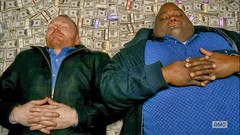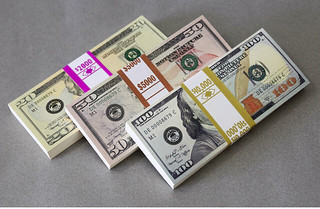
PREV ARTICLE
NEXT ARTICLE
FULL ISSUE
PREV FULL ISSUE
THE BUSINESS OF HOLLYWOOD MOVIE MONEY
Jon Schmeyer forwarded this great article on stage notes or, "Movie Money." Be sure to read the full version online. Thanks!
-Editor
After several days of filming, the sequence was a success. Then, something incredibly odd happened. The bills, which had been supplied by a major Hollywood prop house, were picked up by movie extras and passersby and were attempted to be passed off as legal tender in various stores along the strip. The authorities weren’t too thrilled. Secret Service agents glided in, swiftly detained somewhere north of $100 million worth of prop money, then accused the prop maker -- Independent Studio Services (ISS) -- of counterfeiting, and ordered a cease and desist on all of their faux cash. For ISS (the company who produced the money), the premise of Rush Hour 2 had become a reality -- and they were penned as the bad guy. Sadly, their story is indicative of a constant dilemma faced by prop suppliers in Hollywood: the necessity to skirt the line between strict counterfeiting laws and producers’ demands for incredibly realistic money. Today, “movie money” is ubiquitous and plays a multitude of roles in TV shows and films. It can be seen clutched in the hands of heisters and gangsters, tucked covertly into steel suitcases, and splayed across poker tables in smoky rooms. But as far back as the inception of film (anywhere from 1878 to 1895, depending on one’s definition of the medium), money has been represented on the big screen. Fred Reed, author of Show Me the Money, a book compiling the history of currency in the movies (both real and fake), chronicles how the use of real money gradually transitioned into the use of fake money. Legal tender made its big-screen debut in Thomas Edison’s 1895 kinetoscope film of a cock fight, in which two men wager ferociously; a few years later, in 1903’s The Great Train Robbery, real money was prominently featured during a stick-up scene. But just as film began to flourish in the early 1900s, counterfeiting crimes rose; as a precaution, Federal laws were enacted that barred the use of real currency in full-scale photography. Studios found a replacement in 1920: when the Mexican Revolution ended, vast quantities of Mexican currency, rendered worthless by the war, were acquired by Hollywood producers and used in lieu of U.S. tender. When the supply of these notes diminished a decade later, studios began replicating other Mexican currencies. By the 1960s, this crude prop money was in widespread use.
Gregg Bilson Jr. is the CEO of Independent Studio Services, a Sunland, California-based prop company his father started out of an abandoned Lockheed hangar nearly 40 years ago. Today, his company houses over one million props in seven locations around the United States and Europe. They’ve provided props for nearly every blockbuster movie and hit TV show in the last few decades, from 90210 to Indiana Jones. They also fatefully supplied the prop money for Rush Hour 2, a job that still haunts them 13 years later. When Priceonomics called Bilson to discuss his business, he painstakingly recalled the repercussions of the 2000 incident. The Secret Service came knocking on his door -- first with a cease and desist ordering production of the fake currency be cut off, then again to confiscate all of his digital files and currency inventory as it returned from movie sets around the world. In all, they eradicated nearly $200 million in fake studio bills. At roughly an $8 real money cost per $10,000 stack of fake bills, the loss was steep for the company.
To read the complete article, see:
The Business of Fake Hollywood Money
(priceonomics.com/the-business-of-fake-hollywood-money/)
The Numismatic Bibliomania Society is a non-profit organization promoting numismatic literature. See our web site at coinbooks.org. To submit items for publication in The E-Sylum, write to the Editor at this address: whomren@gmail.com To subscribe go to: https://my.binhost.com/lists/listinfo/esylum All Rights Reserved. NBS Home Page Contact the NBS webmaster 
|

